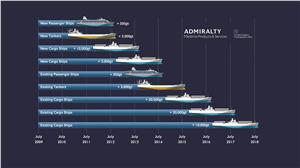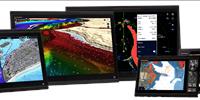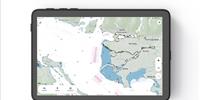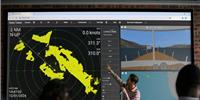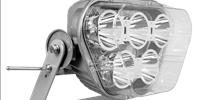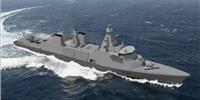Driven by the SOLAS-mandated transition to ECDIS, the adoption of digital navigation is the most visible sign of how navigational practices are being transformed. Additional tools are also playing an important role in supporting bridge teams and delivering accurate navigational information to the bridge.
The ECDIS Tipping Point
We are now halfway through the transition period under the timetable set out in the amendments to the SOLAS Convention adopted in 2009, requiring the mandatory carriage of ECDIS for ships engaged on international voyages. This timetable put in place a series of deadlines for different vessel sizes and classes.
The shipping industry has now reached a pivotal landmark in this process, with UKHO data revealing that over half of ships trading internationally are now living with ECDIS. Of an estimated 41,500 internationally trading ships around the world, almost two thirds subscribe to an ENC service. When those that do not trade internationally are included, 45% of all ships that are subject to the SOLAS regulations are ECDIS ready.
Why does this matter? For the first time, vessels without an ENC service now represent a minority of the internationally trading fleet. This is an important tipping point, as it signals that we are moving out of the ECDIS adoption phase and into a new era. On the basis of this positive trajectory for ECDIS adoption, it also looks as though the shipping industry is on course to comply with the SOLAS-mandated timetable for ECDIS carriage across the global fleet by the end of this decade.
It is also encouraging to see that positive progress towards ECDIS adoption is being made by different categories of ship types and sizes. The proportion of tankers over 3,000 gt using an ENC service has risen from 54% in April 2015 to 69% in October 2015, following the ECDIS carriage rules that entered into force for tankers from July 2015.
The picture is even more encouraging for existing cargo ships over 50,000 gt. At present, 62% of these 3,500 large cargo ships are using an ENC service, ahead of the July 2016 deadline when the SOLAS regulations on ECDIS carriage will be extended to these ships. This is well ahead of where the tanker fleet stood 12 months ago; indicating that the cargo ship fleet is more advanced in its preparations. There are also some interesting variances in ECDIS readiness between different categories of cargo ship. At present, 57% of bulkers are living with ECDIS, compared to 65% of RoRos and 71% of containerships.
This is more than a symbolic landmark. To put it simply, it means that digital navigation isn’t just the future. Today, digital navigation is a reality.
This has an important implication for everyone in the ECDIS supply chain, including ECDIS manufacturers, training providers, shipping companies and mariners. In the past few years, the conversation has been dominated by discussions about how to make the transition to ECDIS, but now we need to spend more time talking about living with ECDIS; how we use, manage and properly maintain digital navigation systems.
Updating ECDIS Software
For ship owners navigating digitally, the focus of their attention must now shift towards the ongoing management and maintenance of ECDIS on a day-to-day basis. It’s vital to understand that ECDIS compliance, and effective ECDIS use, are not the same thing. To begin with, shipping companies must ensure that they put in place revised bridge policies and procedures that reflect the requirements of safe, effective and compliant ECDIS operation. A further priority is the need to upgrade ECDIS software to comply with the latest IHO ENC Standards. Last summer, in response to feedback from mariners, the International Hydrographic Organization (IHO) unveiled a series of important updates to the technical standards that govern the display of Electronic Navigational Charts (ENCs) within an ECDIS.
These updates include a revised Presentation Library within ‘S-52’; the standard that governs the portrayal of an ENC on an ECDIS screen. The latest Presentation Library (version 4.0) addresses the number one complaint levelled at ECDIS by mariners: constant audible alarms. By providing clear guidance to ECDIS manufacturers on ENC objects that will raise an alarm, the IHO has tackled the issue of alarm fatigue on the bridge. In addition, information such as fairway and anchorage area names now appear on screen, with landmarks, lights and buoys viewable via a ‘hover-over’ function. Both initiatives reduce the time-consuming need to find information buried in a pick report.
We strongly encourage all owners to contact their ECDIS manufacturer and plan early for the transition to the updated ECDIS Standards, in order to ensure a smooth switchover and to take advantage of the benefits that the new editions will bring to the bridge.
Nautical Publications Go Digital
Of course, ECDIS is not the only new navigational tool available to mariners. New passage planning resources are equipping bridge teams with faster, more efficient and accurate navigational information. A wide range of official ADMIRALTY nautical publications are now available in an electronic format as e-Nautical Publications (e-NPs). They are designed to meet SOLAS carriage requirements, contain the same information as their paper equivalents and are approved for use by the Flag States of over three-quarters of ships trading internationally.
Unlike their paper counterparts, each e-NP allows bridge officers to download and apply weekly Notices to Mariners (NM) updates in just a few seconds, freeing up their time to focus on other tasks and ensuring greater accuracy on board. Additionally, the new e-Reader snapshot function allows crews to view, save and print e-NP pages and any applicable NMs and addendums, which can be used to support passage planning. Sailing Directions, the Nautical Almanac and the Mariners Handbook are just a few of the publications now available as e-NPs.
Conclusion
The shipping world is embracing digital navigation with growing familiarity and confidence. For shipping companies that have installed ECDIS across their fleet and for mariners now serving on ECDIS-equipped ships, the new challenge is to develop and implement the practices and procedures that will enable them to realize the full benefits for safe and efficient navigation.
The Author
Thomas Mellor is Head of OEM Technical Support and Digital Standards at the United Kingdom Hydrographic Office and Chairman of the IHO’s ENC Working Group.
